Your Assignment: Read Into Thin Air
Along with our discussion of Into Thin Air, we looked at the history of climbing Everest, beginning with the one person who will forever be associated with Everest: George Mallory.
Lost Generation. George Mallory is from the Lost Generation. Mallory is British, but we'll look at this generation from an American perspective:
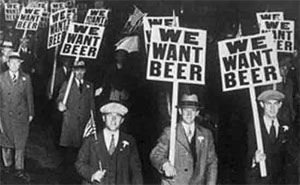 Basics
Basics
Born between 1883 – 1900
Reactive Type
Youth
1880's & 90's Boom Era of Sports
1890's Strikes, Reformers, Evangelism
Rising Adults
1898 Spanish American War
1902 Wright Brothers – First Flight
1914-18 World War I
1918 Great Influenza Epidemic
Adults & Midlife
1920 Women's Suffrage - Prohibition
1929 Stock Market Crash & Depression
1933 Roosevelt's New Deal
Elders
1941 Pearl Harbor – World War II
1945 European War Ends
1950's Cold War
1950-53 Korean War
Summary
- "Lost Generation" was originally applied to
American literary figures living in Paris
after the end of World War I. (Ernest
Hemingway, F. Scott Fitzgerald,
TS Elliot, Sherwood Anderson.)
- Members of the Lost Generation were disillusioned by the large number of deaths from the war, and they became cynical of the idealism and morality of the previous generation, the Missionary Generation.
- The term "Lost Generation" was popularized by Hemingway in his novel The Sun Also Rises: "You are all a lost generation"
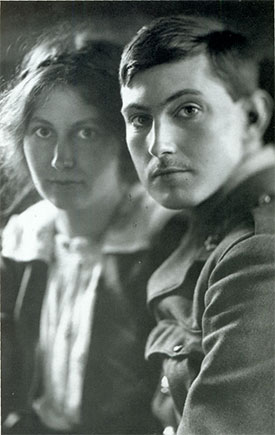 George Mallory
George Mallory
1886 – 1924
Lost Generation
- Son of a minister
- Studied at Cambridge – While there, became associated with a literary and artistic set called the Bloomsbury Group which included the cream of the crop of that generation's literati (Virginia Woolf, E. M. Forster, John Maynard Keynes, Duncan Grant)
- In 1914, he married Ruth Turner. Only six days later, Great Britain went to war with Germany
- Mallory joined the Royal Artillery as an officer and fought on the Western Front. He survived the war. Many members of his generation in Great Britian did not.
- In 1921, he was selected to be on the first British Expedition to Everest
- He returned to Everest on expeditions
in 1922 and 1924. On the 1924 expedition, he and Andrew Irvine, his climbing partner, disappeared on one final attempt to reach the summit.
The following shows Mallory's 1924 route superimposed on a Google Earth image . . .
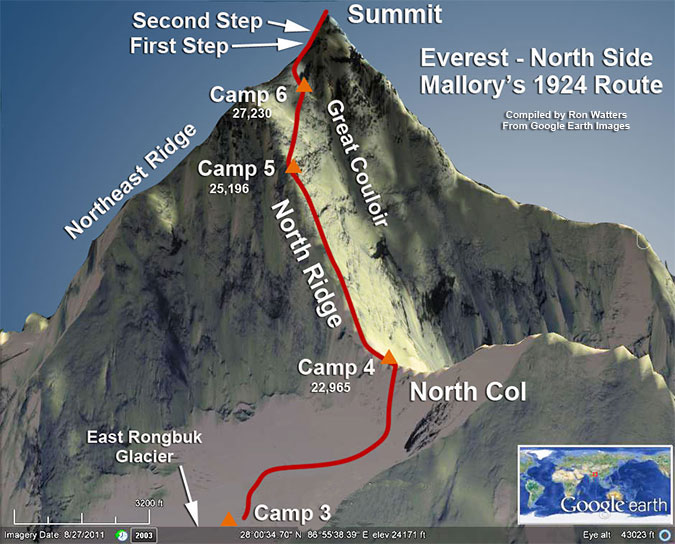
Eric Shipton & Bill Tilman
The next attempts at Everest, as well as other climbing explorations of the Himalaya, were dominated by two British mountaineers: Eric Shipton and Bill Tilman. They weren't successful in reaching Everest's summit, but they did climb many other peaks in the Himalaya. They were known for low-key, small expeditions which Bill Tilman famously said could be "planned on back of an envelope."
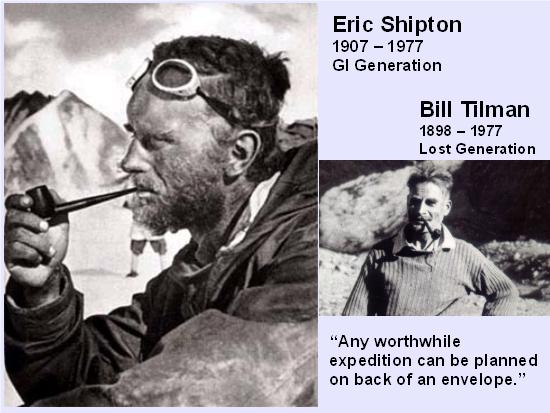
Tenzing Norgay & Edmund Hillary
In 1953, Everest was first successfully climbed by two members of a British expedition: Tenzing Norgay (from Nepal) & Edmund Hillary (from New Zealand).
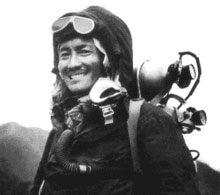
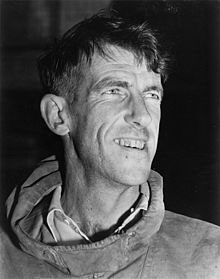
Jim Whittaker, Willi Unsoeld & Tom Hornbein (US)
After Norgay and Hillary's 1953 achievement, a Swiss team made a successful ascent of the mountain. The first American to climb Everest was Jim Whittaker, a member of the 1963 American Expedition.
On that same expedition, Willi Unsoeld and Tom Hornbein's made the first ascent of Everest's west ridge. They descended from the summit via the South Col route, making the first major traverse of a Himalayan peak.
Junko Tabei (Japan)
Junko Tabei is the first woman to reach the summit of Everest (1975).
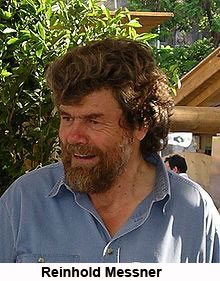 Reinhold Messner and Peter Habeler
Reinhold Messner and Peter Habeler
In 1978, Reinhold Messner (Italy) and Peter Habeler (Austria) were the first to climb Everest without oxygen.
Messner is most famous for his legendary 1980 solo ascent of Everest without supplemental oxygen, climbing from the north side of the mountain.
The following illustration shows the north side routes on Everest, including Messner's solo ascent in 1980:
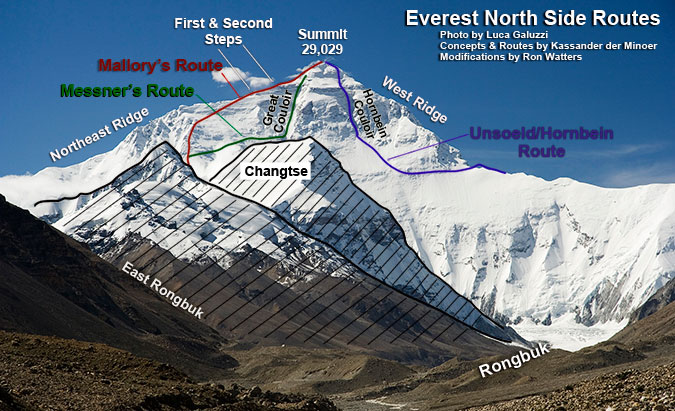
A special thanks to the photographer Luca Galuzzi, and to Kassander der Minoer for researching the routes.
[End]
